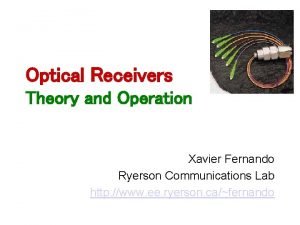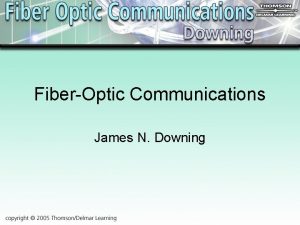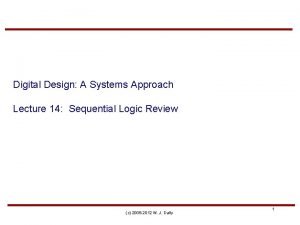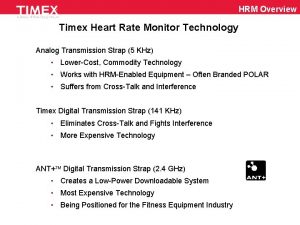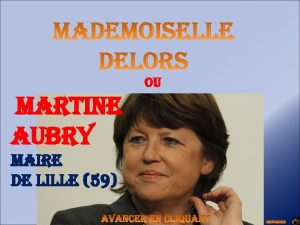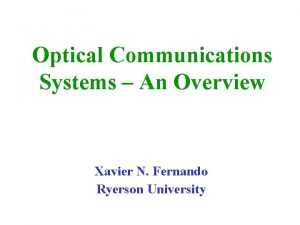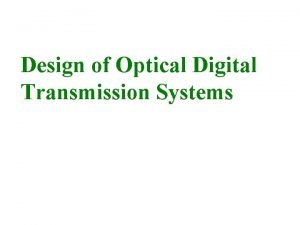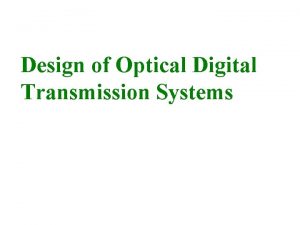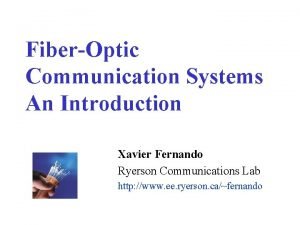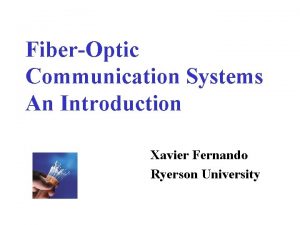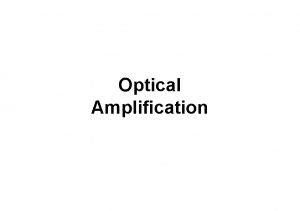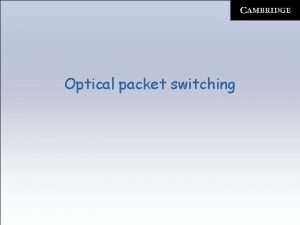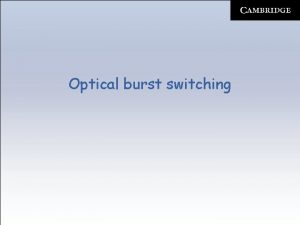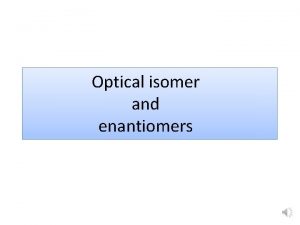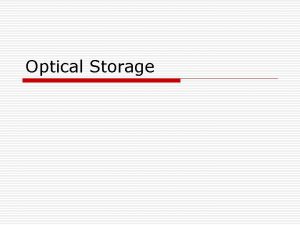Design of Optical Digital Transmission Systems Xavier Fernando

























- Slides: 25

Design of Optical Digital Transmission Systems Xavier Fernando Ryerson University

Point-to-Point Links Key system requirements needed to analyze optical fiber links: 1. The desired (or possible) transmission distance 2. The data rate or channel bandwidth 3. The desired bit-error rate (BER) LED or laser (a) Emission wavelength (b) Spectral line width (c) Output power (d) Effective radiating area (e) Emission pattern MMF or SMF (a) Core size (b) Core index profile (c) BW or dispersion (d) Attenuation (e) NA or MFD pin or APD (a) Responsivity (b) Operating λ (c) Speed (d) Sensitivity

Selecting the Fiber Bit rate and distance are the major factors Other factors to consider: attenuation (depends on? ) and distance-bandwidth product (depends on? ) cost of the connectors, splicing etc. Then decide • Multimode or single mode • Step or graded index fiber

Selecting the Optical Source • Emission wavelength depends on acceptable attenuation and dispersion • Spectral line width depends on acceptable ………… dispersion (LED wide, LASER narrow) • Output power in to the fiber (LED low, LASER high) • Stability, reliability and cost • Driving circuit considerations

Selecting the detector • Type of detector – APD: High sensitivity but complex, high bias voltage (40 V or more) and expensive – PIN: Simpler, thermally stable, low bias voltage (5 V or less) and less expensive • Responsivity (that depends on the avalanche gain & quantum efficiency) • Operating wavelength and spectral selectivity • Speed (capacitance) and photosensitive area • Sensitivity (depends on noise and gain)

Typical bit rates at different wavelengths Wavelength LED Systems LASER Systems. 800 -900 nm 150 Mb/s. km (Typically Multimode Fiber) 2500 Mb/s. km 1300 nm (Lowest 1500 Mb/s. km dispersion) 25 Gb/s. km (In. Ga. As. P Laser) 1550 nm (Lowest 1200 Mb/s. km Attenuation) Up to 500 Gb/s. km (Best demo)

Design Considerations • Link Power Budget – There is enough power margin in the system to meet the given BER • Rise Time Budget – Each element of the link is fast enough to meet the given bit rate These two budgets give necessary conditions for satisfactory operation

Optical power-loss model Try Ex: 8. 1

Power Budget Example • • • Specify a 20 -Mb/s data rate and a BER = 10– 9. With a Si pin photodiode at 850 nm, the required receiver input signal is – 42 d. Bm. Select a Ga. Al. As LED that couples 50 m. W into a 50 -μm core diameter fiber flylead. Assume a 1 -d. B loss occurs at each cable interface and a 6 -d. B system margin. The possible transmission distance L = 6 km can be found from PT = PS – PR = 29 d. B = 2 lc + αL + system margin = 2(1 d. B) + αL + 6 d. B • The link power budget can be represented graphically (see the right-hand figure).

Example: Spreadsheet Power Budget

Rise-Time Budget (1) • A rise-time budget analysis determines the dispersion limitation of an optical fiber link. • The total rise time tsys is the root sum square of the rise times from each contributor ti to the pulse rise-time degradation: – – The transmitter rise time ttx The group-velocity dispersion (GVD) rise time t. GVD of the fiber The modal dispersion rise time tmod of the fiber The receiver rise time trx Here Be and B 0 are given in MHz, so all times are in ns.

Rise-Time Budget (2) 12

Short-Wavelength Band Attenuation and dispersion limits on the transmission distance vs. data rate for a 770– 910 -nm LED/pin combination. • The BER was 10– 9 ; the fiber-coupled power was – 13 d. Bm up to 200 Mb/s. • The attenuation limit curve was derived by using a fiber loss of 3. 5 d. B/km • The receiver sensitivities shown in the left figure (8. 3) 13

Attenuation-Limited Distances for Two Single-Mode Links 1. 2. 3. 4. 5. 6. A DFB laser that has a fiber-coupled output of 0 d. Bm at 1550 nm. At 1550 nm the single-mode fiber has a 0. 20 -d. B/km attenuation. The receiver has a load resistor RL = 200 Ω and T = 300°K. At a 10– 12 BER a value of Q = 7 is needed. The In. Ga. As pin and APD photodiodes have a responsivity of 0. 95 A/W. The gain of the APD is M = 10 and the noise figure F(M ) = 5 d. B. 14

Power Penalties • • When any signal impairments are present, a lower optical power level arrives at the receiver compared to the ideal reception case. This lower power results in a reduced SNR, which leads to a higher BER. The ratio of the reduced received signal power to the ideal received power is the power penalty for that effect and is expressed in decibels. If Pideal and Pimpair are the received optical powers for the ideal and impaired cases, respectively, then the power penalty PPx in decibels for impairment x is • In some cases, increasing the received optical power can reduce the power penalty. For other cases (some nonlinear effects) increasing the received power level will have no effect on the power penalty. • Power penalties may be due to chromatic dispersions and polarizationmode dispersion, modal (speckle) noise, mode-partition noise, the extinction ratio, chirp, timing jitter, reflection noise, and nonlinear effects arising from high optical power level in a fiber link. 15

Chromatic Dispersion Penalty • Chromatic dispersion arises since each wavelength has a slightly different velocity, and thus they arrive at different times at the fiber end. • Therefore, the range of arrival times at the fiber end of the spectrum of wavelengths will lead to pulse spreading. • The accumulated chromatic dispersion increases with distance. • A basic estimate of what limitation chromatic dispersion imposes on link performance can be made by specifying that the accumulated dispersion should be less than a fraction ε of the bit period Tb = 1/B, where B is the bit rate: The ITU-T Rec. G. 957 for SDH and the Telcordia Generic Requirement GR-253 for SONET: • For a 1 -d. B power penalty the accumulated dispersion should be less than 0. 306 of a bit period (ε ≤ 0. 306). • For a 2 -d. B power penalty the requirement is ε ≤ 0. 491. 16

Polarization-Mode Dispersion Penalty • Polarization-mode dispersion (PMD) arises since light-signal energy at a given wavelength in a single-mode fiber occupies two orthogonal polarization states or modes. • PMD arises because the two fundamental orthogonal polarization modes travel at slightly different speeds owing to fiber birefringence. • This PMD effect cannot be mitigated easily and can be for links operating at 10 Gb/s and higher. • To have a power penalty < 1. 0 d. B, pulse spreading from PMD must on the average be less than 10% of a bit period Tb: 17

Extinction Ratio Power Penalty • Let P 1 -ER and P 0 -ER are the logic 1 and logic 0 power levels, respectively. • Then the extinction ratio re in a laser is the ratio of P 1 -ER to the power level P 0 -ER, that is, re = P 1 -ER / P 0 -ER. • With a nonzero extinction ratio, the average power is • When receiver thermal noise dominates, the 1 and 0 noise powers are equal and independent of the signal level. In this case, letting P 0 -ER = 0 and P 1 -ER = 2 Pave, the extinction ratio power penalty becomes, • Optical transmitters usually have minimum re of 7 to 10 (8. 5 to 10 d. B). • The power penalties range from 1. 25 to 0. 87 d. B. • A minimum re = 18 is needed for an ER power penalty < 0. 5 d. B.

Chirping Power Penalty • A single-mode laser may experience dynamic line broadening when the injection current is directly modulated called “chirp”. • Chirping can produce significant dispersion when the laser wavelength is displaced from the zero-dispersion wavelength of the fiber. • When the effect of laser chirp is small, the eye closure Δ can be approximated by • The power penalty for an APD can be estimated from the SNR degradation (in d. B) due to the signal amplitude decrease as, where x is the excess noise factor of the APD 19

ER and Chirping Power Penalties Extinction-ratio, chirping, and total-system power penalties at 1550 nm for a 4 -Gb/s 100 -km single-mode G. 652 link having a dispersion D = 17 ps/(nmkm) and a DFB laser with an active layer width of 1. 75 mm. (From Corvini and Koch, Ref. 53. ) 20

Coherent Fiber Links • We have been looking at Intensity Modulated / Direct Detection (IM/DD) links so far where only optical power is considered (on-off modulation). • The detector detects only the power (square law detection) • In coherent fiber optic links both the amplitude and phase of the light wave is considered. • Receiver should be phase locked to the transmitter. This is done by having another ‘phase locked laser’ at the receiver • In coherent links, phase modulations (FM, QAM, QPSK etc. ) are possible. Superior performance. Very high bit rates.

Coherent Detection • Coherent detection provides gain to the incoming optical signal by combining or mixing it with a locally generated continuous-wave (CW) optical field. • The result of the mixing is that the dominant noise in the receiver is the shot noise coming from the local oscillator. • Thus the receiver can have a shot noise limited sensitivity.

Differential Quadrature Phase-Shift Keying • Multilevel modulation formats are of interest for 10 and 40 Gb/s speeds • This modulation format transmits more than one bit per symbol. • In the DQPSK method, information is encoded by means of the four phase shifts {0, + π/2, - π /2, π}. • The set of bit pairs {00, 10, 01, 11} is assigned to individual phase shifts. – For example, a phase shift of π means that the bit pair 11 was sent. • Thus DQPSK transmits at a symbol rate of half the aggregate bit rate. • A DQPSK transmitter typically uses two nested Mach-Zehnder modulators 23

BER Comparisons

Comparison of Number of Required Photons per Bit 25
 Xavier fernando ryerson
Xavier fernando ryerson Linear polarization
Linear polarization Xavier fernando
Xavier fernando Digital systems testing and testable design
Digital systems testing and testable design Digital design a systems approach
Digital design a systems approach Digital design: a systems approach
Digital design: a systems approach Digital system design using verilog
Digital system design using verilog Advantages of digital modulation
Advantages of digital modulation Data encoding and transmission
Data encoding and transmission Analog digital transmission
Analog digital transmission Analog and digital signals in computer networking
Analog and digital signals in computer networking Hrm digital data transmission
Hrm digital data transmission Motion transmission examples
Motion transmission examples Types of motion transmission systems
Types of motion transmission systems Motion transmission systems
Motion transmission systems Mechanical design of transmission line
Mechanical design of transmission line Etties character in the mark
Etties character in the mark Xavier van rooyen
Xavier van rooyen Xavier barberis
Xavier barberis Xavier aubry
Xavier aubry Henri-françois-xavier de belsunce de castelmoron
Henri-françois-xavier de belsunce de castelmoron Hannah xavier
Hannah xavier Xavier gimeno
Xavier gimeno House of capet family tree
House of capet family tree Mdvpn
Mdvpn The death of mr xavier answer key
The death of mr xavier answer key
